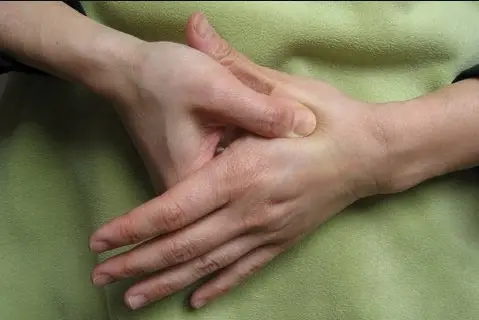What Causes Pain Between Thumb and Index Finger?
Pain between your thumb and index finger is an injury that should not be treated lightly. For one thing, it can greatly diminish, or worse, completely prohibit your ability to grasp an object between your thumb and index finger. That is something we probably take for granted, but once it’s gone, you will see that you actually lose out on doing a number of things.
If you are experiencing pain that’s between the thumb and index finger, it is most likely caused by one of two things: injury or carpal tunnel syndrome. We’ll examine both cases so that you can be best informed as to why you have the pain and they know the best plan of action to treat it.
Contents
The Causes of The Pain Between Thumb and Index Finger
The main causes of the pain between thumb and index finger are:
Injury (aka Skier’s Thumb)
Any sort of blunt force trauma to the thumb can cause pain in the webbing between the thumb and index finger. The force of the trauma can damage the soft tissue that connects the bones of the thumb together leading to pain. It is commonly referred to as skier’s thumb because this injury is common among skiers (hitting the ground while their hand is gripped around the pole is usually how the injury occurs) but you don’t have to hit the slopes in order to get this pain.
Read: Skier’s Thumb in-depth
Look for these symptoms to determine if you think your pain is caused by trauma:
- Pain in the webbing between your thumb and index finger.
- The inability to grasp objects between your thumb and index finger.
- Discoloration of your thumb (usually black and blue).
- You can’t move your thumb from side to side without it hurting.
If you exhibit these symptoms, the best course of action is to see a doctor. If you can’t get to one right away, treat the pain with ice, and keep the area immobilized the best you can. A doctor will treat this injury with either a splint or cast or if necessary, corrective surgery.
Carpal Tunnel Syndrome
Carpal Tunnel Syndrome is a more severe problem than blunt force injury to your thumb and index finger. While blunt force trauma damages tissue, carpal tunnel syndrome indicates nerve damage. Check with your doctor if you display some of these symptoms:
- Numbness in your hand, forearm, or wrist severe enough that it awakens you at night.
- Occasional tingling sensation, like “pins and needles,” or pain in your hand, thumb, or fingers.
- Numbing or pain that gets worse when you use your hand.
- Stiffness in your fingers when you wake up in the morning.
Essentially what is happening here is the median nerve, a nerve that runs along a narrow passageway (the carpal tunnel) on the palm side of your wrist, is a pinch and/or compressed. This nerve controls movement and sensation in your thumb and the first three fingers, and this pinching is what causes the pain or weakness. It’s important to note if your pinky finger is the finger experiencing pain it is not carpal tunnel syndrome.
It is important to see a doctor if these symptoms persist for more than 2 weeks. Carpal Tunnel Syndrome can be treated with therapy and protective splints, or if necessary, surgery to repair the ligaments.
De Quervain’s Tenosynovitis
You develop this condition when the tendons around the base of your thumb become strangled or irritated. In this condition, you are likely to experience pain on the thumb side of your wrist. The most common symptoms are:
- Pain and swelling around the base of the thumb.
- Difficulty moving wrist and thumb.
- A “stick” feeling when you try to move your thumb.
Basal Joint Arthritis
You develop this condition because of cartilage damage in the bones as the cartilage begins to wear with the passage of time. This makes it difficult to perform small moving tasks. The more joint damage occurs when you continue to use your thumb. The most common symptoms of basal joint arthritis or thumb arthritis are as follows:
- The pain when you clasp or something from the handle, especially between the thumb and the index.
- The pain and tenderness in your thumb.
- Stiffness in the thumb.
- Swelling at the base of the thumb with a bone hump.
Age and Genetics
The most common form of arthritis affecting the thumb joint is osteoarthritis. The exact cause of osteoarthritis is unknown; However, it can occur with age and normal wear and tear. Some people are also born more likely to develop this condition, says MayoClinic.com. The risk for development of mixed basal arthritis is greater in women and people over 40 years of age. Although there is no cure from 2010, there are medications, injections, and restraint techniques that can help manage the symptoms.
Conclusion
You use your hands for almost every day, and this excessive use can cause injuries to the ligaments and muscles that pass through this area. The most common cause of the pain between thumb and index finger results from repeated use of the wrist. Such as typing on the computer or using the mouse incorrectly.
The condition must be diagnosed well before starting any treatment. And may require x-ray on the thumb to exclude the fracture of the zodiacal.
In general, you can use a wrist brace, which is available online.
It also benefits you to do an ice massage using an ice cube for three minutes two or three times a day.
With any type of injury, early detection is key and seeing a doctor is essential. So, don’t ignore the pain between your thumb and index finger. Because the longer the wait, the more problematic it can become.
What Causes Pain Between Thumb and Index Finger? Last Updated: 3/11//2017


